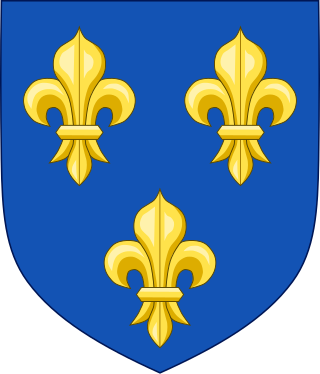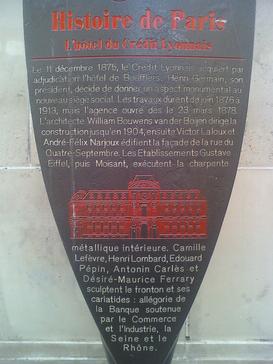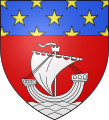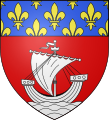
The national flag of France is a tricolour featuring three vertical bands coloured blue, white, and red. It is known to English speakers as the Tricolour, although the flag of Ireland and others are also so known. The design was adopted after the French Revolution, where the revolutionaries were influenced by the horizontally striped red-white-blue flag of the Netherlands. While not the first tricolour, it became one of the most influential flags in history. The tricolour scheme was later adopted by many other nations in Europe and elsewhere, and, according to the Encyclopædia Britannica has historically stood "in symbolic opposition to the autocratic and clericalist royal standards of the past".

The fleur-de-lis, also spelled fleur-de-lys, is a common heraldic charge in the shape of a lily. Most notably, the fleur-de-lis is depicted on the traditional coat of arms of France that was used from the High Middle Ages until the French Revolution in 1792, and then again in brief periods in the 19th century. This design still represents France and the House of Bourbon in the form of marshalling in the arms of Spain, Quebec and Canada, for example.

The Arms of Canada, also known as the Royal Coat of Arms of Canada or, formally, as the Arms of His Majesty the King in Right of Canada, is the arms of dominion of the Canadian monarch and, thus, also the official coat of arms of Canada. In use since 1921, it is closely modelled after the royal coat of arms of the United Kingdom, with French and distinctive Canadian elements replacing or added to those derived from the British version.

The flag of Quebec, called the Fleurdelisé, represents the Canadian province of Quebec. It consists of a white cross on a blue background, with four white fleurs-de-lis.

The coat of arms of Quebec was adopted by order-in-council of the Government of Quebec on 9 December 1939, replacing the arms assigned by royal warrant of Queen Victoria on 26 May 1868.

The coat of arms of France depicts a lictor's fasces upon branches of laurel and oak, as well as a ribbon bearing the national motto of Liberté, égalité, fraternité. The full achievement includes the star and grand collar of the Legion of Honour. This composition was created in 1905 by heraldic painter-engraver Maurice de Meyère, and has been used at the Foreign Ministry during state visits and for presidential inaugurations.

The first coat of arms of Montreal was designed by Jacques Viger, the first mayor of Montreal, and adopted in 1833 by the city councillors. Modifications were made some one hundred five years later and adopted on 21 March 1938, and again on 13 September 2017, resulting in the version currently in use. The coat of arms was the only city emblem representing Montreal until 1981, when a stylized logo was developed for common daily use, reserving the coat of arms for ceremonial occasions.

The coat of arms of Alabama depicts a shield upon which is carried the symbols of the five states which have at various times held sovereignty over a part or the whole of what is now Alabama. These are the ancient coat of arms of France, the ancient coat of arms of Crown of Castile for Spain, the modern Union Jack of the United Kingdom and the battle flag of the Confederate States. On an escutcheon of pretence is borne the shield of the United States. The crest of the coat represents a ship which brought the French colonists who established the first permanent European settlements in the territory. Below is the state motto: Audemus jura nostra defendere, meaning "We dare defend our rights."

Dammarie-lès-Lys is a commune in the south-eastern suburbs of Paris, France. It is located in the Seine-et-Marne department in the Île-de-France region 43.3 km (26.9 mi) from the center of Paris.

The Spanish autonomous community and province of La Rioja has a coat of arms, which was assigned to the former province of Logroño in 1957, and to the present autonomous community on its foundation in 1982. It consists of a shield which is divided vertically into two halves, featuring respectively the Cross of Saint James and a castle, and is surmounted by a royal crown. Also depicted are Monte Laturce and the Ebro river.
The people and province of Quebec have created and established several symbols throughout Quebec's history to represent the collective identity of its residents. Many of Quebec's symbols are related to its history, to catholicism, to Quebec's winters and/or the fauna and flora of Quebec. The motif most commonly seen in Quebec's various symbols is the fleur de lys, which is associated with the French language and New France.

The coat of arms of French Guiana, a région of France located in South America, consists of a boat full of gold on a green river, charged with three white water lilies. In chief, the fleurs-de-lis of France appear beneath the date 1643. On either side of the shield is an anteater.
There are currently two symbols of Brussels. Both the flag and the emblem of the Brussels-Capital Region depict the Iris pseudacorus, a flower native to the Brussels area. Additionally, every municipality of the region has its own flag and coat of arms.

French heraldry is the use of heraldic symbols in France. Although it had a considerable history, existing from the 12th century, such formality has largely died out in France, as far as regulated personal heraldry is concerned. Civic heraldry on the other hand remains a visible part of daily life.

The "Histoire de Paris" plaques are information plaques scattered throughout the City of Paris in front of various Parisian monuments.

National symbols of France are emblems of the French Republic and French people, and they are the cornerstone of the nation's republican tradition.

The flag of Carillon was flown by the troops of General Louis-Joseph de Montcalm during the Battle of Carillon, which was fought by the French and Canadian forces against those of the British in July 1758 at Fort Carillon.

The coat of arms of Marseille has witnessed its existence since the 14th century. The current version was adopted in 1883.

The coat of arms of Lyon, the ancient capital of the Gauls, reflects the rich history of the city across different periods of its existence and the power that has exercised authority over the city. It was created in 1320, although the current version, which dates from 1859, reprises the form that it had before the end of the Ancien Régime after having undergone several temporary modifications.

The Council of Heraldry and Vexillology is the Heraldic authority for the French-speaking Community of Belgium. It is the institution that advises the Government of the French-speaking Community on all matters concerning civic, personal, and familial arms and flags. Grants of arms from the Council are published in the Belgian official journal.































